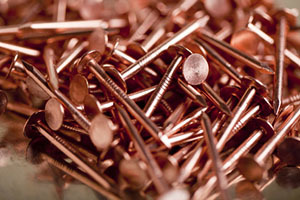Prana Biotech's new trial of PBT2 in Huntington's disease: the lowdown
Prana Biotech's PBT2 trial in Huntington's disease: what we know so far & what copper has to do with the mutant prote
 By Professor Ed Wild October 03, 2011 Edited by Dr Jeff Carroll
By Professor Ed Wild October 03, 2011 Edited by Dr Jeff Carroll
Prana Biotech has announced a phase 2 clinical trial in Huntington’s disease patients in Australia and the USA. Here’s what we know so far about the trial, the company, the drug and the friendship between copper and the mutant huntingtin protein.
PBT2 clinical trial announced
A new international clinical trial of a drug that might slow the progression of Huntington’s disease is bound to cause excitement. When the trial’s launch coincides with the opening of the Huntington’s Disease World Congress, and the company behind the trial is based in the town hosting the Congress, headlines are sure to follow.

So you may already have heard that Prana Biotech‘s drug PBT2 will be tested in an international clinical trial, beginning late 2011 in Australia and the USA. We’re here to give you as much detail as we can about the trial and the drug, as well as examining the evidence that PBT2 might work in Huntington’s disease.
The trial
Drug trials involving humans are divided into three phases.
Phase 1 is when healthy volunteers are given a drug for the first time. In phase 2, the drug is given to patients with symptoms for the first time, but the main aim is to check it’s safe and doesn’t make things worse. Phase 3 trials are much larger, involving many hundreds of volunteers, and aim to provide the evidence required to get a drug approved.
Prana’s PBT2 trial in Huntington’s is a phase 2 trial - so, it’ll be quite small overall, involving a hundred volunteers. In a press release, the company says it’s aiming to involve about 15 sites in Australia and the US - that means an average of six to seven volunteers per site. The trial will involve people with 'early’ Huntington’s disease. Broadly speaking, that means people who have HD symptoms like involuntary movements, that are fairly mild and don’t prevent them walking, working or functioning at home.
Each early HD volunteer will be enrolled for six months, but because the company hasn’t yet announced the full trial design, we can’t tell you how many volunteers will be given the drug and how many a placebo pill, containing no drug, for comparison. Nor do we know what tests will be used to assess the effect of the drug, and whether the trial will involve things like MRI brain scanning.
Another unknown is which sites will be chosen for the trial in Australia and the USA, but Massachusetts General Hospital in Boston, USA and Johns Hopkins University in Baltimore have been confirmed as partners. Given Prana’s local connection, we’ll be surprised if Melbourne isn’t also included as an Australian site.
The company has announced that the results are expected by late 2013.
Because it’s a phase 2 trial, the main aims will be to make sure the drug is ‘safe and well tolerated’ - in other words, that it doesn’t cause a worsening of symptoms or any unexpected side effects, and to settle on the best dose for larger phase 3 studies. But the company will also be hoping that the phase 2 trials will give a suggestion that PBT2 can change the disease in the right direction, to give the confidence to proceed to an expensive phase 3 trial.
The company
“If metals can help proteins to do good, can they also contribute to the harm caused by abnormal proteins? ”
Prana Biotech is a relatively small pharmaceutical company, founded in Melbourne in 1997. In Hindu philosophy, ‘prana’ is a powerful, mysterious force that sustains life. Prana’s research is rather more down-to-earth, though: it focuses on the interactions between proteins - the molecular machines that carry out most important functions in our cells - and metals.
The idea that our bodies rely on metals might sound odd but we’re all familiar, at least from Popeye cartoons, with the idea that iron is essential for health. The same’s true of many other metals - sometimes called ‘trace elements’.
Proteins and metals: unexpected friends
Iron’s a pretty good example of an important interaction between proteins and metals. Our blood carries oxygen from the air we breathe to our organs, inside our red blood cells. Those cells are red because they contain a red protein called hemoglobin. But the oxygen-carrying power of hemoglobin relies on a tiny amount of iron, locked deep inside the protein. Lack of iron causes anemia, which makes people pale and breathless because their blood can’t carry enough oxygen.
Researchers are increasingly aware that many proteins need a little help from metals to get their work done. But we also know that proteins can go bad, and cause harm. The mutant huntingtin protein, produced in the cells of people with an expanded HD gene, is a perfect example, but there are many others: Alzheimer’s and Parkinson’s are both diseases in which proteins cause harm and form clumps called ‘aggregates’ in brain cells.
So if metals can help proteins to do good, can they also contribute to the harm caused by abnormal proteins? Increasingly, researchers think so, and that’s the answer Prana is betting on.
Copper, PBT2 and Alzheimer’s
Prana is particularly interested in the role played by copper in the harmful effects of abnormal proteins. PBT2 was developed as a treatment for Alzheimer’s disease, where the protein that causes damage, ’amyloid’, becomes more sticky when copper atoms attach to it. PBT reduces the amount of copper that attaches to amyloid.
In a 2008 phase 2 trial of PBT2, published in Lancet Neurology, treatment of Alzheimer’s patients with PBT2 appeared to reduce the amount of amyloid protein in the spinal fluid that surrounds the brain, and the drug didn’t cause serious side effects. Prana is now planning further studies to look for effects of PBT2 on amyloid levels in the brain, and working towards a large phase 3 trial in Alzheimer’s.
What about Huntington’s disease?

Possible effects of copper in Huntington’s disease haven’t been studied in as much detail as in Alzheimer’s. What we know, though, is that copper deposits have been found in the worst-affected brain regions, and the huntingtin protein has several areas that copper atoms can attach to.
At the International Conference on Alzheimer’s Disease and Related Disorders in 2010, Prof. Robert Cherny of Prana Biotech presented data from a trial of PBT2 in HD model mice. Animals given the drug had improved movement control and lived around 40% longer than untreated mice. This success in the HD mouse model is the basis for Prana’s decision to perform a clinical trial in Huntington’s disease patients.
PBT2 and copper in context
It’s refreshing to see a new player like Prana enter the field of Huntington’s disease research, because it’s hard to see how we’ll find and test treatments to slow HD without pharmaceutical companies.
Because caution is a good seasoning for optimism, it’s worth mentioning a couple of things about PBT2.
While the results for PBT2 in the HD mice are encouraging, there’s no escaping the fact that, so far, every drug that’s worked in an HD mouse has failed to show benefits when tested in humans. Of course, that will be true until the first drug works in patients - and PBT2 might be that drug. But because no mouse is a perfect model of human Huntington’s disease, many experienced HD researchers now feel that a new drug should be tested in several different animal models before being taken into human trials.
Bearing in mind our ‘ten golden rules’ for reading an HD news story, we also note that Prana’s HD mouse results were reported at a scientific conference, but haven’t yet been published in a peer-reviewed scientific journal - where they’d be scrutinized more closely by independent experts before being accepted.
Finally, we understand that anyone with HD or at risk wants to know what they can do now to give their brain the best fighting chance. But we’d like to point out that if copper is important in HD, it’s not because there’s too much copper in the brain or body overall. So, there’s no reason to believe that restricting copper in the diet, or taking supplements to remove copper, would be beneficial for people with the HD mutation.
With these caveats in mind, we look forward to hearing more details of the trial as they emerge, and we’ll keep you posted of any major developments.


